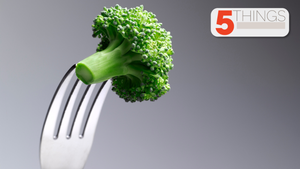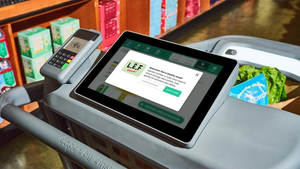HEALTHY HISPANICS
Hispanics favor scratch cooking with fresh vegetables, fruit and legumes and grains. Yet they also love whole milk and eggs, and organ meats for their texture and taste. Latinos love their food they love the richness and flavor, said Suzanne Kuczun, spokesperson for Bogopa USA, which operates 14 stores under the Food Bazaar and Food Dimensions banners in New York and New Jersey. Couple that with the
April 14, 2008
CAROL ANGRISANI
Hispanics favor scratch cooking with fresh vegetables, fruit and legumes and grains. Yet they also love whole milk and eggs, and organ meats for their texture and taste.
“Latinos love their food — they love the richness and flavor,” said Suzanne Kuczun, spokesperson for Bogopa USA, which operates 14 stores under the Food Bazaar and Food Dimensions banners in New York and New Jersey.

Couple that with the availability and relative affordability of fast food in the U.S., and Hispanics — and their children — often find they put on weight after they arrive in America.
“Over time, harried lifestyles, working moms, increased exposure to package foods advertising, a greater orientation to convenience, and increased affluence drive significant changes in the Hispanic diet,” said Terry Soto, president and chief marketing officer of About Marketing Solutions, a Burbank, Calif.-based consulting firm specializing in the Hispanic market.
What's more, Hispanics often view weight gain as a good thing, because they associate it with health and affluence.
But there's a consequence to their eating habits and their genetic makeup: There are high rates of obesity and diabetes within the demographic.
At a time when retailers are rolling out shelf-edge nutrition guidance programs, hiring store dietitians and even launching chainwide weight-loss programs, many have learned that a one-size-fits-all approach won't help them effectively reach the Hispanic market.
That's why a growing number of retailers are developing nutrition programs that help to reinforce the healthy food behavior Hispanics bring from their countries of origin, and also give them a greater appreciation for healthier options available here in the United States.
Several retailers are tying in with “Que Rica Vida” (What a Rich and Wonderful Life), a Hispanic outreach program from General Mills that includes a free quarterly Spanish-language magazine and a website, www.quericavida.com, filled with tips and information on such topics as health, education, meal occasions and holiday celebrations. The program recently added a new component: It now brings mobile health and wellness “classrooms” to retailer nutrition events. The classrooms promote the health attributes of various General Mills brands, such as heart health in the case of Cheerios.
“Many times, Hispanics suffer from multiple illnesses, such as heart [-related conditions] and obesity,” said Rudy Rodriguez, General Mills' multicultural marketing director. “The challenge is to educate them in a unique and entertaining way.”
General Mills has already run 10 such health events and plans to continue the effort this year.
Along with supporting vendor events, retailers have established their own initiatives. Retail giant Wal-Mart is using its in-store television network to run Spanish-language cooking segments from Telemundo, according to PRN Network, the San Francisco-based provider of the in-store media network.
The spots feature easy-to-prepare recipes and cooking tips based on the season, such as Rollitos de Pollo (Chicken Rolls & Broccoli) and Crema de Mejillones (Clam Soup).
The Telemundo content runs in about 166 Wal-Mart Supercenters and stores, according to PRN.
Among other efforts, Publix prints healthy recipes on bilingual recipe cards distributed as part of its Apron's Simple Meals program. Apron's provides in-store demonstrations of a complete meal, with all the items needed to create the meal being found nearby.
“The goal is to show customers that you don't have to sacrifice taste in healthier options,” said Publix spokeswoman Maria Brous.
Publix also distributes Camino Mágico brochures in its Publix Sabor stores. Created by the Latino Nutrition Coalition, an educational program founded by Boston-based food think tank Oldways Preservation Trust, Camino Mágico is a free pocket-size supermarket guide for Hispanics. The 16-page booklet contains an Updated Latin American Diet Pyramid, a calorie-control guide; information about food labels; and recipes and meal ideas.
The brochures are available at Publix's communication centers and customer service desks.
Bogopa USA started carrying Camino Mágico pamphlets last year because they fit in with its goal of offering Hispanics traditional recipes with healthier ingredients, according to Kuczun.
“We want to show them how they can eat healthy food, but still have the taste they want,” she said.
Bogopa has already distributed 40,000 copies of Camino Mágico pamphlets and plans to distribute another 40,000 by year-end.
“Camino Mágico is a great beginning tool,” Kuczun said.
The chain soon will bring the pamphlet to life by conducting demos of some of the recipes featured in it. Within the next few weeks, Bogopa USA will start weekly Camino Mágico meal demonstrations. Frequency will increase as the program becomes established.
“Education is so important when it comes to the Hispanic market,” she said. “It's our job to show them how to incorporate healthy alternatives into their diet.”
Kuczun said many Hispanics won't try to eat healthier until they're diagnosed with a health ailment. That's why Spanish-language prevention efforts can go a long way.
“A lot of Hispanics live in Hispanic communities, work and socialize with Spanish-speaking people,” she said. “It's so important to speak to them in their language.”
Camino Mágico does just that by addressing traditional ways of eating and adapting them to the American lifestyle, said Oldways spokeswoman Kezia Frayjo.
The pamphlet is being distributed in 10 states in stores including Albertsons and Minyard Food Stores' Carnival banner. Winn-Dixie plans to start carrying Camino Mágico this summer, according to Frayjo.
Even retailers that aren't located in heavily Hispanic areas, such as Shaws, are supporting the effort.
Retailers are displaying the pamphlets in various locations, including in the dairy, produce and ethnic aisles, at the register and in the health and wellness section of the store.
Hispanics appreciate the pamphlet, because it explains the various kinds of nutrition messaging consumers see on retailers' shelves and on product packaging. Like mainstream consumers, Hispanics are often confused about the different health and wellness messaging at retail, such as the difference between low-fat, no-fat and fat-free.
Minyard Food Stores, Coppell, Texas, recently ordered 100,000 copies to distribute in its 23 Carnival stores in North Texas.
“Once they get acculturated, Hispanics tend to eat more like Americans, “ said Minyard pharmacy vice president Ron Peters. “We want to help change that mind-set and get them to eat as they would back home.”
Camino Mágico joins a number of other Hispanic services Minyard provides. For instance, the retailer just started testing “Kids in the Kitchen” at its newly remodeled Carnival-banner store in Plano. Under the program, Hispanic youngsters are invited to the store for demonstrations about choosing and preparing healthy snacks in the store's kitchen, called “The Cocina.”
“It's a way to get kids in the store and show them how easy it is to make healthy snacks,” Minyard's chief executive officer, Mike Byars, told SN.
About 100 kids have participated since the program launched a month ago. Minyard plans to roll it out to all of its Carnival stores this year.
About the Author
You May Also Like






